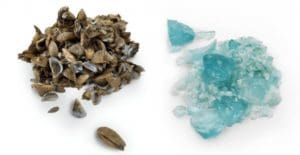CCS Team Wins International Biodesign Challenge
June 23, 2020A team of CCS students took the grand prize at this year’s Biodesign Challenge, an international education program and competition that partners students with biologists, artists, and designers to envision, create, and critique emerging biotechnology.

A team of CCS graduate students took the grand prize at this year’s Biodesign Challenge (BDC), an international education program and competition that partners students with biologists, artists, and designers to envision, create, and critique emerging biotechnology.
The CCS team presented their project, “Zebra Glass,” at the Biodesign Challenge Summit alongside 44 other student teams from countries around the world. Each project was judged by a panel of 50 esteemed experts from academia, the arts, and industry. This year’s finalists were from 12 countries across six continents.
“Zebra Glass” proposes using zebra and quagga mussels, which are invasive to the Great Lakes ecosystem, as a source of calcium carbonate in the creation of region-based artisanal soda lime glass. The project seeks to transform these species from an ecological threat to an over-abundant resource that can be harvested and used for various building applications.
The winning project was a collaborative effort by CCS MFA Color & Materials Design students Mahsa Banadaki, Emily Marquette, and CCS MFA Integrated Design student Wei Huang under the guidance of adjunct professor Matthew Strong. The team also worked interdepartmentally with assistance from CCS Craft & Material Studies Chair Kim Harty and Assistant Professor and Section Head of Ceramics, Ebitenyefa Baralaye. Not only did the team demonstrate their creativity, but also their adaptability and resilience as they worked under the added challenge of a global pandemic.
When discussing the future of the winning project, student Emily Marquette explained, “We hope to continue to gather samples of Zebra and Quagga Mussels from the remaining Great Lakes and repeat our glassmaking process. Our goal is to compare the final color results of the glass based on region.”
Chair of CCS Color & Materials Design, Sally Erickson Wilson added, “There are already plans for Zebra Glass 2.0 and the larger movement of ‘better’ materials. Our vision in Color & Materials Design is that student work creates outcomes via non-obvious, material-led practices that result in a creative vision. Then, working with cross-disciplinary teams, students translate that vision into viable concepts. These projects are conversation starters, where we hope people, consumers and businesses start paying attention.”
In years past, competition participants would have presented their projects at the Museum of Modern Art in New York City, but this year, due to the pandemic, BDC had to pivot to an online format.
Past BDC teams have turned their projects into venture-backed companies and have collectively raised over $2.5 million in funds. Their projects and designs have won awards including the H&M Global Change Award and the National Geographic Chasing Genius Award. They have also exhibited at museums, galleries, and design festivals around the world, including Dutch Design Week, NYCxDesign, London Design Festival, the Tech Museum, and elsewhere.
Zebra Glass Project Press Coverage:
Designboom
Fast Company
DNYUZ
Watch the winning video presentation below:
